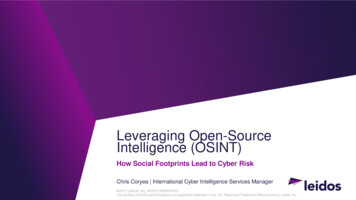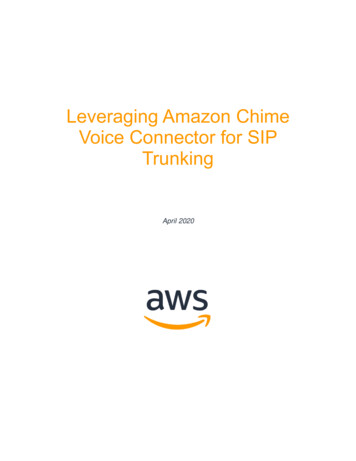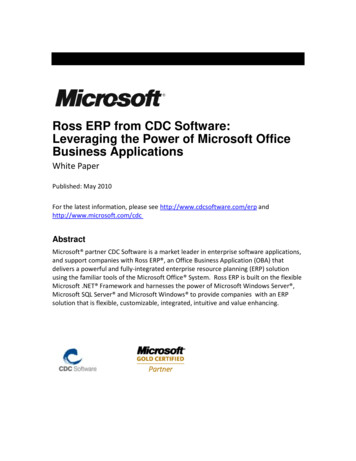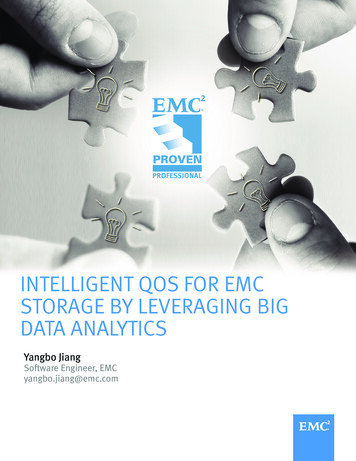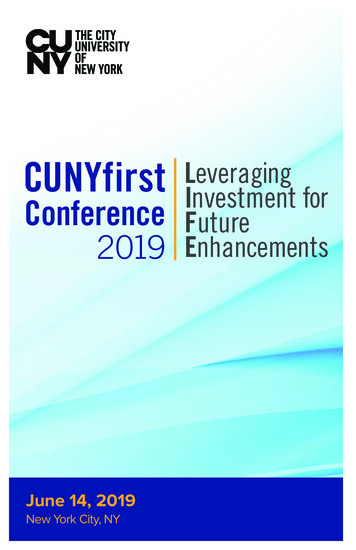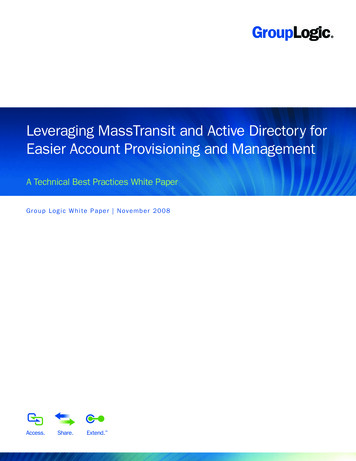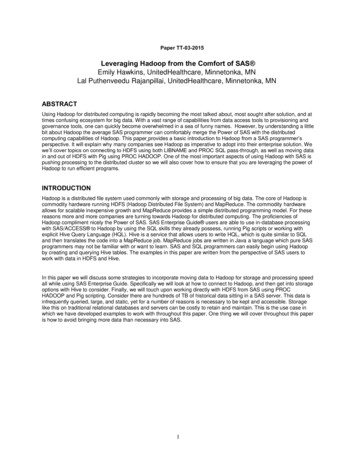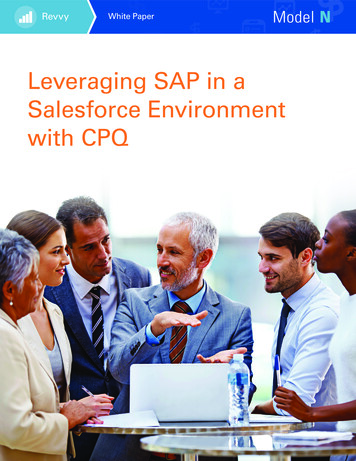
Transcription
RevvyWhite PaperLeveraging SAP in aSalesforce Environmentwith CPQ
RevvyWhite PaperThe Key Takeaways Companies using SAP ERP are adopting Salesforce as a platform for digital transformation and customer engagementIn these companies, SAP ERP is the system of record for the critical data and the operational infrastructure necessaryto enable digital transformation initiativesThere are two approaches for SAP ERP customers with Salesforce: move the data and processes out of SAP, or buildupon SAP as a foundationCPQ is emerging as a catalyst for the leverage of SAP in Salesforce. The challenge for most Salesforce CPQ solutionsis that they were not designed for this purposeDirectly leveraging SAP natively in Salesforce is possible with Revvy CPQ for SAP which was designed from theground up to interoperate with SAP pricing procedures, SAP Variant Configurator and SAP Order Managementout of the boxThere are over 100 companies using the patented technology that enables the seamless interoperabilitybetween Revvy CPQ and SAP ERPA New Focus on GrowthOver the last several decades, enterprises have leveraged information technologyand business process re-engineering to become lean and cut costs. Thesecompanies have spent millions of dollars to improve efficiency and drive savingsto the bottom line. This trend in corporate investment fostered the growth of themajor packaged application platforms, and in particular SAP which has become thecore operational backbone of many of the world’s leading companies.However, CEOs today have shifted their focus from cost savings throughautomation toward driving growth through transforming their company’sengagement with the customer using digital technologies. A recent McKinsey studycites that over three quarters of the executives they surveyed said that the primarystrategic intent behind their digital initiatives is to drive growth either in buildingexisting businesses or opening new business opportunities.“CEOs haveshiftedfocus fromcutting costto drivinggrowth.”Digital transformation initiatives have the highest levels of visibility at many companies, with over 40% of McKinsey’srespondents indicating that their CEO’s had responsibility for their digital transformations. In addition, customerengagement is confirmed as the leading area of focus for corporate digital transformation. Over 50% of executives in theMcKinsey study ranked customer engagement in the top two for both strategy and spending for digital transformation.Salesforce as the Customer Success PlatformDigital transformation is ushering in a new world of technology to the corporate IT landscape. Cloud computing,mobile, social, and big data are emerging technologies that are shaping and enabling transformation efforts. The providersof emerging technologies are also establishing new corporate technology platforms.2
RevvyWhite PaperSalesforce has become a leading platform for digital transformation.The company has positioned itself as the customer success platformfueled by rapid growth in front-office applications, particularly CustomerRelationship Management (CRM). According to industry analyst GartnerGroup, almost 50% of all CRM applications sales in 2014 were cloud-basedand Salesforce leads the market with almost 20% of worldwide market-share.Salesforce revenues are growing at almost four times faster than the nextnearest competitor.As a result many companies, that have made major investments in SAPare also bringing the Salesforce platform into their organizations to transformengagement with customers at every point in the customer life cycle.But this is posing some challenges for their corporate IT organizations.For many enterprises, SAP ERP has been the system of record for corefinancial and manufacturing processes, and the backbone for efficientoperations of the company.“Over 50%of executivesrank customerengagement atop priority.”Initial projects in digital transformation have often been limited to front office processes that are independent of core ERPsystems. However, as companies expand their efforts to drive growth they often find that the critical data required toachieve their objectives is in the corporate ERP.A Bridge Between SAP and SalesforceSAP and Salesforce are two systems representing two worlds. One very structured, bullet-proofed and the transactionsystem of record. The other flexible, customer facing and the relationship system of record. At Model N, we see agrowing requirement to bridge the worlds of Salesforce with SAP in a way that leverages SAP strengths as the coresystems of record for the enterprise.This is different from the cloud-for-everything approach that encourages transfer of data out of the ERP, or actualreplacement of ERP functionality. The technology suppliers in this camp advocate moving from on premise to the cloudfor all the end-to-end processes involved in digital transformation. For example, quote-to-cash applications propose tomove core processes such as order management outside of the ERP. MostModel N customers have invested significantly in their SAP systems and donot find this approach attractive for a host of reasons, including the possibilityof errors in duplicate data and the additional costs of implementing andmanaging redundant systems.“Over 100companiesmanaging 200 billionannually onModel N.”3Model N’s heritage has been to augment the ERP with mission criticalmanagement of the end-to-end revenue lifecycle. For over 16 years, ModelN has been successfully delivering enterprise grade Revenue Managementapplications including pricing, quoting, contract life cycle management,rebates and channel management on a global scale. These applicationsmanage over 200 billion in annual revenues in over 100 countries andare designed to be interoperable with our customer’s ERP systems, inparticular SAP.
RevvyWhite PaperModel N is bringing that proven expertise to the Salesforce platform in a suite of applications called Revvy RevenueManagement. These applications are built natively on the Salesforce platform and are designed specifically to leveragethe data and operational applications within SAP ERP.CPQ – A Lynch Pin Unifying the Two WorldsA lynch pin in the unification of Salesforce and SAP is the Configure Price Quote (CPQ) application. CPQ is a powerfuldriver for growth in organizations doing digital transformation. A study by AMR Research showed an over 55% increasein cross-sell and up-sell rates by companies employing CPQ solutions. CPQ is also a effective driver for transformationof sales. An Aberdeen study found that organizations using CPQ saw an increase of 45% in responsiveness to customerinquiries and a 28% reduction in sales cycles.While first generation Salesforce native CPQ solutions primarily focused on automating the quoting process, Model Nsaw CPQ as a critical point of convergence of data, process and organizations in digital transformation. Our enterprisecustomers wanted to build from the foundation of pricing and product information in SAP and utilize existing SAPoperational infrastructure such as financials. manufacturing and order management. In this approach, CPQ becomes theconduit for interoperability between SAP and the Salesforce platform, aligning data and organizations and leveraging coreback-office systems into a unified solution.“Using CPQdrove a 55%increase incross-sell andup-sell.”When addressing these enterprise level requirements, other CPQ solutionsrely on custom integrations to SAP as a part of their implementationprojects. Integrations to SAP are not new to corporate IT organizations, butexperience has shown that they are complicated and expensive to maintainand enhance as business changes.In particular, integrations with CPQ pose additional challenges. For example,SAP is typically the system of record for pricing. Any pricing of products orservices exposed in the digital transformation project should be exactly as ifpriced in the SAP system.To achieve this, a typical Salesforce native CPQ application will attemptSAP pricing integration through real-time BAPI calls. However, thatmethod has significant drawbacks including performance, error handling,monitoring and ongoing supportability. These CPQ solutions use a ‘chatty’integration, making frequent and expensive calls between Salesforce and SAP. Some solutions may try to get aroundthis by implementing a “calculate price” or “re-price” button in the UI, which results in a less than optimum end userexperience. In addition, this integration performs the ‘Create Order’ BAPI call that simulates placing a sales order toreturn customer specific prices. Dependent on the number of order lines and complexity of pricing procedures this is oneof the most computing intensive transactions in the SAP system.Considering that these integrations are custom projects, the cost to operate and maintain integrations is quite heavy.There are significant data transformation and mapping requirements to make the data consumable by the CPQ tool.Typically, direct integrations are limited to less complex data operations. In addition, using web services and direct4
RevvyWhite PaperBAPI calls, though technically feasible, requires an extra layer of services tomonitor, log, trace, and recover when necessary. Direct API-like calls canbe fragile and changes on either side of the process can have an impact.This adds an extra layer of planning, effort and cost to any modifications thebusiness needs to make as it reacts to changing business requirements.“Typicalintegrations are‘chatty’ makingfrequent calls.”Integrations with product data are equally, if not more complex. In general,typical Salesforce CPQ solutions try to export the data from SAP andduplicate the data in their systems through some type of conversion.However, if the translations can be made to work, it will invariably deliverpoor performance. Alternatively, the data and rules can be recreated withinthe modeling environment of the CPQ application to gain better performance. Both approaches increase the possibility oferrors and create a maintenance nightmare of testing, optimizations and retesting to get it to work exactly as in the SAPsystem. What’s even worse is that the implementation process is repeated with every change.Building SAP into a Salesforce Native CPQModel N started with the principle that interoperability with SAP would be the basic use case for Revvy CPQ. Ratherthan rely on a bolt-on approach using integrations, Revvy CPQ for SAP was built with patented technology that leveragesthe pricing and product configuration data directly in SAP without the chatty interface, maintenance and cost issuesassociated with integrations. With Revvy CPQ for SAP products are priced and configured exactly as they would be inthe SAP system, but all business logic is run natively in Salesforce. And conversions of quotes to orders result in fullfunctioning orders in SAP order management systems. This approach enables a native Salesforce quote to cash processthat seamlessly incorporates existing SAP data and systems as a fundamental component of the architecture.The breakthrough to seamless interoperability is a patented technology that synchronizes Revvy CPQ with SAP pricingand SAP VC, keeping SAP the system of record. Revvy CPQ’s SAP engine has three services that enable Revvy to priceand configure products natively in Salesforce exactly as if they were beingpriced and configured in SAP. The first is a service that extracts SAP prices,including standard or custom price conditions, price access sequence,price procedures, and the entire KMAT knowledgebase of the SAP VariantConfiguration. The second is a service that compiles the extracted data intoan in-memory runtime component of the Revvy SAP engine. The third is theservice that executes the pricing and configuration based on the compiledversions of the data from SAP.“Patentedtechnologyenables SAPpricing andconfigurationin Salesforce.”5The materials master is also extracted from SAP using Revvy’s builtin Enterprise Application Integration technology (EAI) combined withSalesforce native web services. The SAP data is loaded into theRevvy CPQ catalog. This data can then be augmented by catalogadministrators with additional product attributes, images, rich text,marketing materials, product specific terms and conditions, as wellas assigned to a category in a sales catalog.
RevvyWhite PaperProduct configuration and pricing during quoting occurs natively in Salesforce by utilizing the Revvy SAP engine whichincludes the compiled price and configuration data from SAP as an in-memory service. This unique architecture avoidsround trip calls to SAP for each product configuration or price change during quoting, and delivers a solution that is highlyoptimized for fastest performance and is scalable to thousands of concurrent users.Placing an order from a quote will send orders to SAP also using Salesforce Web Services and Revvy EAI in real-time.After order placement in SAP, the Quotes in Revvy CPQ will have the SAP order number so sales can follow-up on theorder. The order placed in SAP by Revvy CPQ is identical to the quote and is functionally complete so that it may bereconfigured or re-priced in SAP without issue if order changes need to be performed by sales operations.The technology that drives the Revvy SAP engine has been proven over 10 years in hundreds of companies using SAP forcomplex configured products and services in industries including automotive, industrial manufacturing, high tech, HVACand life science.6
RevvyWhite PaperPrice and Configure Exactly Like SAP ERPThe most common use case for Revvy CPQ for SAP, and one that delivers significant value, is to leverage SAP pricingand VC natively in a Salesforce environment. Companies can transform customer engagement and provide directsales reps and channels sales reps an easier more flexible user experience without the additional burden and costs ofintegration. With Revvy CPQ for
Companies using SAP ERP are adopting Salesforce as a platform for digital transformation and customer engagement In these companies, SAP ERP is the system of record for the critical data and the operational infrastructure necessary




